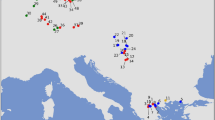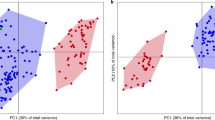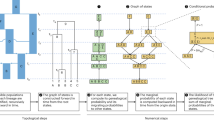Abstract
Genomic and ancient DNA data have revolutionized palaeoanthropology and our vision of human evolution, with indisputable landmarks like the sequencing of Neanderthal and Denisovan genomes. Yet, using genetic data to identify, date and quantify evolutionary events—such as ancient bottlenecks or admixture—is not straightforward, as inferences may depend on model assumptions. In the last two decades, the idea that Neanderthals and members of the Homo sapiens lineage interbred has gained momentum. From the status of unlikely theory, it has reached consensus among human evolutionary biologists. This theory is mainly supported by statistical approaches that depend on demographic models minimizing or ignoring population structure, despite its widespread occurrence and the fact that, when ignored, population structure can lead to the inference of spurious demographic events. We simulated genomic data under a structured and admixture-free model of human evolution, and found that all the tested admixture approaches identified long Neanderthal fragments in our simulated genomes and an admixture event that never took place. We also observed that several published admixture models failed to predict important empirical diversity or admixture statistics, and that we could identify several scenarios from our structured model that better predicted these statistics jointly. Using a simulated time series of ancient DNA, the structured scenarios could also predict the trajectory of the empirical D statistics. Our results suggest that models accounting for population structure are fundamental to improve our understanding of human evolution, and that admixture between Neanderthals and H. sapiens needs to be re-evaluated in the light of structured models. Beyond the Neanderthal case, we argue that ancient hybridization events, which are increasingly documented in many species, including with other hominins, may also benefit from such re-evaluation.
This is a preview of subscription content, access via your institution
Access options
Access Nature and 54 other Nature Portfolio journals
Get Nature+, our best-value online-access subscription
$32.99 / 30 days
cancel any time
Subscribe to this journal
Receive 12 digital issues and online access to articles
$119.00 per year
only $9.92 per issue
Buy this article
- Purchase on SpringerLink
- Instant access to full article PDF
Prices may be subject to local taxes which are calculated during checkout



Similar content being viewed by others
Data availability
No genomic datasets were generated for this study. Some analyses relied on the public AADR v.54.1 dataset downloaded from https://reich.hms.harvard.edu/allen-ancient-dna-resource-aadr-downloadable-genotypes-present-day-and-ancient-dna-data.
Code availability
All the scripts used in this study (including, but not limited to, model simulation and plotting, statistics calculation, run selection, model comparison, figure plotting) as well as the demes YAML-formatted demographic histories of the 20 selected scenarios are publicly available at https://github.com/sunyatin/qna.
References
Beaumont, M. A. Recent developments in genetic data analysis: what can they tell us about human demographic history? Heredity 92, 365–379 (2004).
Goldstein, D. B. & Chikhi, L. Human migrations and population structure: what we know and why it matters. Annu. Rev. Genomics Hum. Genet. 3, 129–152 (2002).
Harding, R. M. & McVean, G. A structured ancestral population for the evolution of modern humans. Curr. Opin. Genet. Dev. 14, 667–674 (2004).
Ramachandran, S. et al. Support from the relationship of genetic and geographic distance in human populations for a serial founder effect originating in Africa. Proc. Natl Acad. Sci. USA 102, 15942–15947 (2005).
Mazet, O., Rodríguez, W., Grusea, S., Boitard, S. & Chikhi, L. On the importance of being structured: instantaneous coalescence rates and human evolution—lessons for ancestral population size inference? Heredity 116, 362–371 (2016).
Rodríguez, W. et al. The IICR and the non-stationary structured coalescent: towards demographic inference with arbitrary changes in population structure. Heredity 121, 663–678 (2018).
Arredondo, A. et al. Inferring number of populations and changes in connectivity under the n-island model. Heredity 126, 896–912 (2021).
Ragsdale, A. P. et al. A weakly structured stem for human origins in Africa. Nature 617, 755–763 (2023).
Scerri, E. M. L. et al. Did our species evolve in subdivided populations across Africa, and why does it matter? Trends Ecol. Evol. 33, 582–594 (2018).
Scerri, E. M. L., Chikhi, L. & Thomas, M. G. Beyond multiregional and simple out-of-Africa models of human evolution. Nat. Ecol. Evol. 3, 1370–1372 (2019).
Prado-Martinez, J. et al. Great ape genetic diversity and population history. Nature 499, 471–475 (2013).
Lester, J. D. et al. Recent genetic connectivity and clinal variation in chimpanzees. Commun. Biol. 4, 283 (2021).
Steux, C. et al. On the demographic history of chimpanzees and some consequences of integrating population structure in chimpanzees and other great apes. Preprint at bioRxiv https://doi.org/10.1101/2024.06.14.599042 (2024).
Li, H. & Durbin, R. Inference of human population history from individual whole-genome sequences. Nature 475, 493–496 (2011).
Gutenkunst, R. N., Hernandez, R. D., Williamson, S. H. & Bustamante, C. D. Inferring the joint demographic history of multiple populations from multidimensional SNP frequency data. PLoS Genet. 5, e1000695 (2009).
Currat, M. & Excoffier, L. Modern humans did not admix with Neanderthals during their range expansion into Europe. PLoS Biol. 2, e421 (2004).
Beaumont, M. A., Zhang, W. & Balding, D. J. Approximate Bayesian computation in population genetics. Genetics 162, 2025–2035 (2002).
Gerbault, P. et al. Storytelling and story testing in domestication. Proc. Natl Acad. Sci. USA 111, 6159–6164 (2014).
Chikhi, L. Basato su una storia vera: come fanno i genetisti delle popolazioni umane a conoscere le storie che raccontano? in Evoluzione umana e origini di Homo sapiens - XLVII Seminario sulla Evoluzione biologica e i grandi problemi della biologia (ed Segre, B.) 181–211 (Bardi Edizioni, 2023).
Wakeley, J. Nonequilibrium migration in human history. Genetics 153, 1863–1871 (1999).
Chikhi, L., Sousa, V. C., Luisi, P., Goossens, B. & Beaumont, M. A. The confounding effects of population structure, genetic diversity and the sampling scheme on the detection and quantification of population size changes. Genetics 186, 983–995 (2010).
Battey, C. J., Ralph, P. L. & Kern, A. D. Space is the place: effects of continuous spatial structure on analysis of population genetic data. Genetics 215, 193–214 (2020).
Green, R. E. et al. A draft sequence of the Neandertal genome. Science 328, 710–722 (2010).
Sankararaman, S., Patterson, N., Li, H., Pääbo, S. & Reich, D. The date of interbreeding between Neandertals and modern humans. PLoS Genet. 8, e1002947 (2012).
Eriksson, A. & Manica, A. Effect of ancient population structure on the degree of polymorphism shared between modern human populations and ancient hominins. Proc. Natl Acad. Sci. USA 109, 13956–13960 (2012).
Eriksson, A. & Manica, A. The doubly conditioned frequency spectrum does not distinguish between ancient population structure and hybridization. Mol. Biol. Evol. 31, 1618–1621 (2014).
Durand, E. Y., Patterson, N., Reich, D. & Slatkin, M. Testing for ancient admixture between closely related populations. Mol. Biol. Evol. 28, 2239–2252 (2011).
Yang, M. A., Malaspinas, Anna-Sapfo, Durand, E. Y. & Slatkin, M. Ancient structure in Africa unlikely to explain Neanderthal and non-African genetic similarity. Mol. Biol. Evol. 29, 2987–2995 (2012).
Lohse, K. & Frantz, L. A. F. Neandertal admixture in Eurasia confirmed by maximum-likelihood analysis of three genomes. Genetics 196, 1241–1251 (2014).
Sankararaman, S. et al. The genomic landscape of Neanderthal ancestry in present-day humans. Nature 507, 354–357 (2014).
Racimo, F., Sankararaman, S., Nielsen, R. & Huerta-Sánchez, E. Evidence for archaic adaptive introgression in humans. Nat. Rev. Genet. 16, 359–371 (2015).
Sankararaman, S. Methods for detecting introgressed archaic sequences. Curr. Opin. Genet. Dev. 62, 85–90 (2020).
Amos, W. Signals interpreted as archaic introgression appear to be driven primarily by faster evolution in Africa. R. Soc. Open Sci. 7, 191900 (2020).
Fu, Q. et al. An early modern human from Romania with a recent Neanderthal ancestor. Nature 524, 216–219 (2015).
Hajdinjak, M. et al. Initial Upper Palaeolithic humans in Europe had recent Neanderthal ancestry. Nature 592, 253–257 (2021).
Notohara, M. The coalescent and the genealogical process in geographically structured population. J. Math. Biol. 29, 59–75 (1990).
Herbots, H. M. J. D. Stochastic Models in Population Genetics: Genealogy and Genetic Differentiation in Structured Populations. PhD thesis, Queen Mary Univ. London (1994).
Wilkinson-Herbots, H. M. Genealogy and subpopulation differentiation under various models of population structure. J. Math. Biol. 37, 535–585 (1998).
Takahata, N. Genealogy of neutral genes and spreading of selected mutations in a geographically structured population. Genetics 129, 585–595 (1991).
Hudson, R. R. in Oxford Surveys in Evolutionary Biology Vol. 7 (eds Futuyama, D. & Antonovics, J.) 1–44 (Oxford Univ. Press, 1991).
Tajima, F. Relationship between migration and DNA polymorphism in a local population. Genetics 126, 231–234 (1990).
Bhatia, G., Patterson, N., Sankararaman, S. & Price, A. L. Estimating and interpreting FST: the impact of rare variants. Genome Res. 23, 1514–1521 (2013).
Browning, S. R., Browning, B. L., Zhou, Y., Tucci, S. & Akey, J. M. Analysis of human sequence data reveals two pulses of archaic Denisovan admixture. Cell 173, 53–61 (2018).
Keinan, A., Mullikin, J. C., Patterson, N. & Reich, D. Accelerated genetic drift on chromosome X during the human dispersal out of Africa. Nat. Genet. 41, 66–70 (2009).
Durbin, R. M. et al. A map of human genome variation from population-scale sequencing. Nature 467, 1061–1073 (2010).
Schaefer, N. K., Shapiro, B. & Green, R. E. An ancestral recombination graph of human, Neanderthal, and Denisovan genomes. Sci. Adv. 7, eabc0776 (2021).
Skoglund, P. et al. Origins and genetic legacy of Neolithic farmers and hunter-gatherers in Europe. Science 336, 466–469 (2012).
Moorjani, P. et al. A genetic method for dating ancient genomes provides a direct estimate of human generation interval in the last 45,000 years. Proc. Natl Acad. Sci. USA 113, 5652–5657 (2016).
Fu, Q. et al. Genome sequence of a 45,000-year-old modern human from western Siberia. Nature 514, 445–449 (2014).
Lemaire, L., Jay, F., Lee, I., Csilléry, K. & Blum, M. G. Goodness-of-fit statistics for approximate Bayesian computation. Preprint at https://arxiv.org/abs/1601.04096 (2016).
Gower, G., Picazo, P. I., Fumagalli, M. & Racimo, F. Detecting adaptive introgression in human evolution using convolutional neural networks. eLife 10, e64669 (2021).
Ragsdale, A. P. & Gravel, S. Models of archaic admixture and recent history from two-locus statistics. PLoS Genet. 15, e1008204 (2019).
Nordborg, M. On the probability of Neanderthal ancestry. Am. J. Hum. Genet. 63, 1237–1240 (1998).
Edmonds, C. A., Lillie, A. S. & Cavalli-Sforza, L. L. Mutations arising in the wave front of an expanding population. Proc. Natl Acad. Sci. USA 101, 975–979 (2004).
Currat, M. & Excoffier, L. The effect of the Neolithic expansion on European molecular diversity. Proc. R. Soc. B 272, 679–688 (2005).
Chikhi, L. et al. The IICR (inverse instantaneous coalescence rate) as a summary of genomic diversity: Insights into demographic inference and model choice. Heredity 120, 13–24 (2018).
Currat, M. et al. Comment on “Ongoing adaptive evolution of ASPM, a brain size determinant in Homo sapiens” and “Microcephalin, a gene regulating brain size, continues to evolve adaptively in humans”. Science 313, 172 (2006).
Ahlquist, K. D. et al. Our tangled family tree: new genomic methods offer insight into the legacy of archaic admixture. Genome Biol. Evol. 13, evab115 (2021).
Theunert, C. & Slatkin, M. Distinguishing recent admixture from ancestral population structure. Genome Biol. Evol. 9, 427–437 (2017).
Vernot, B. & Akey, J. M. Resurrecting surviving Neandertal lineages from modern human genomes. Science 343, 1017–1021 (2014).
Beichman, A. C., Phung, T. N. & Lohmueller, K. E. Comparison of single genome and allele frequency data reveals discordant demographic histories. G3 7, 3605–3620 (2017).
Zeberg, H. et al. A Neanderthal sodium channel increases pain sensitivity in present-day humans. Curr. Biol. 30, 3465–3469.e4 (2020).
Zeberg, H. & Pääbo, S. The major genetic risk factor for severe COVID-19 is inherited from Neanderthals. Nature 587, 610–612 (2020).
Talamo, S., Kromer, B., Richards, M. P. & Wacker, L. Back to the future: the advantage of studying key events in human evolution using a new high resolution radiocarbon method. PLoS ONE 18, e0280598 (2023).
Prüfer, K. et al. A high-coverage Neandertal genome from Vindija Cave in Croatia. Science 358, 655–658 (2017).
Kelleher, J., Etheridge, A. M. & McVean, G. Efficient coalescent simulation and genealogical analysis for large sample sizes. PLoS Comput. Biol. 12, e1004842 (2016).
Baumdicker, F. et al. Efficient ancestry and mutation simulation with msprime 1.0. Genetics 220, iyab229 (2022).
Halldorsson, B. V. et al. Characterizing mutagenic effects of recombination through a sequence-level genetic map. Science 363, eaau1043 (2019).
Jónsson, H. et al. Parental influence on human germline de novo mutations in 1,548 trios from Iceland. Nature 549, 519–522 (2017).
Skov, L. et al. The nature of Neanderthal introgression revealed by 27,566 Icelandic genomes. Nature 582, 78–83 (2020).
Durvasula, A. & Sankararaman, S. Recovering signals of ghost archaic introgression in African populations. Sci. Adv. 6, eaax5097 (2020).
Iasi, L. N. M., Ringbauer, H. & Peter, B. M. An extended admixture pulse model reveals the limitations to human–Neandertal introgression dating. Mol. Biol. Evol. 38, 5156–5174 (2021).
Jacobs, G. S. et al. Multiple deeply divergent Denisovan ancestries in Papuans. Cell 177, 1010–1021 (2019).
Kamm, J., Terhorst, J., Durbin, R. & Song, Y. S. Efficiently inferring the demographic history of many populations with allele count data. J. Am. Stat. Assoc. 115, 1472–1487 (2020).
Acknowledgements
We thank O. Mazet, S. Boitard, B. Parreira, A. Arredondo, P. Faux, B. Servin, F. Halkett, R. Leblois and members of the Population and Conservation Genetic group for their support and for useful discussions on this topic. We would also like to acknowledge the Bioinformatic Unit and the Informatics Team of the IGC, as well as CALMIP (project P23002) for their help and support with computational resources. We also thank O. Mazet and S. Boitard for their useful comments on the first version of this manuscript. L.C. and R.T. were funded by Fundação para a Ciência e Tecnologia (ref. PTDC-BIA-EVL/30815/2017, L.C.). This work was also supported by the LABEX entitled TULIP (ANR-10-LABX-41 and ANR-11-IDEX-0002-02, L.C. and R.T.), the IRP BEEG-B (International Research Project—Bioinformatics, Ecology, Evolution, Genomics and Behaviour, L.C.) as well as the DevOCGen project, funded by the Occitanie Regional Council’s ‘Key Challenges BiodivOc’ programme. We acknowledge an Investissement d’Avenir grant of the Agence Nationale de la Recherche (CEBA: ANR-10-LABX-25-01, L.C. and R.T.).
Author information
Authors and Affiliations
Contributions
R.T. and L.C. designed the study. R.T. wrote the scripts, performed the simulations and analysed the data. R.T. and L.C. interpreted the results and wrote the manuscript.
Corresponding authors
Ethics declarations
Competing interests
The authors declare no competing interests.
Peer review
Peer review information
Nature Ecology & Evolution thanks Vagheesh Narasimhan, Joshua Schraiber and the other, anonymous, reviewer(s) for their contribution to the peer review of this work. Peer reviewer reports are available.
Additional information
Publisher’s note Springer Nature remains neutral with regard to jurisdictional claims in published maps and institutional affiliations.
Supplementary information
Supplementary Information
Supplementary Text, Figs. 1–74, Tables 1–17 and References.
Rights and permissions
Springer Nature or its licensor (e.g. a society or other partner) holds exclusive rights to this article under a publishing agreement with the author(s) or other rightsholder(s); author self-archiving of the accepted manuscript version of this article is solely governed by the terms of such publishing agreement and applicable law.
About this article
Cite this article
Tournebize, R., Chikhi, L. Ignoring population structure in hominin evolutionary models can lead to the inference of spurious admixture events. Nat Ecol Evol 9, 225–236 (2025). https://doi.org/10.1038/s41559-024-02591-6
Received:
Accepted:
Published:
Issue date:
DOI: https://doi.org/10.1038/s41559-024-02591-6



